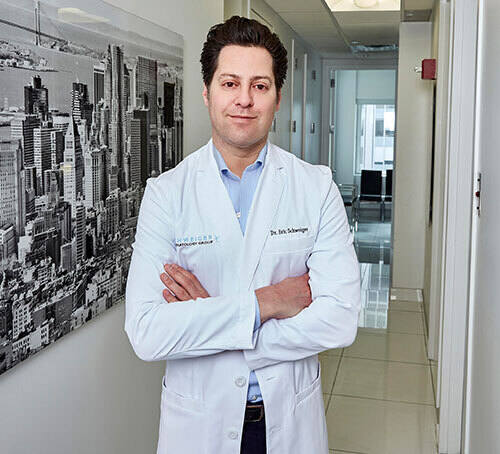Pediatric Acne
 As a sign of the times, our pediatric dermatology providers see an increase in pediatric acne cases. This influx of pediatric acne cases may be due to children hitting puberty earlier than previous generations.
As a sign of the times, our pediatric dermatology providers see an increase in pediatric acne cases. This influx of pediatric acne cases may be due to children hitting puberty earlier than previous generations.
At Schweiger Dermatology Group, our pediatric dermatologists offer a number of safe ways to treat pediatric acne, including topic prescription medications, oral antibiotics, and laser and light therapy.
Pediatric Acne Before Adolescence
Some children start to see acne outbreaks as early as age 8. Early acne can usually be spotted on and around the nose and then spreads to the forehead, cheeks, and chin as the condition worsens. Acne may first appear as red bumps (papules), closed whiteheads, or open blackheads.
Remember that almost every child gets acne on their way to adolescence and early treatment can stop the problem from worsening.
Understanding Acne in Children
Acne usually occurs when the pores on the skin get clogged with dead skin cells and oil (sebum) secreted by the sebaceous glands. Bacteria that are normally present on the skin may also get into the clogged pores, causing infection and inflammation. Inflamed acne causes red, painful bumps or sores that may appear as:
- Pustules. Bacteria cause the hair follicles to be inflamed and pustules form closer to the skin surface.
- Papules. The wall of the hair follicle gets irritated, and papules form deep in the skin.
- Nodules. This type of acne is larger, deeper, and more solid.
- Cysts. This is a nodule with pus.
Causes of Pediatric Acne
There is no one cause for pediatric acne but it may be linked to any one or more of the following:
- Change in hormones due to puberty, or menstrual cycle
- Increase in sebum production and dead skin cells due to a rise in the levels of male sex hormones (androgens) in both boys and girls during puberty
- Use of makeup or cosmetics that block the pores
- Use of harsh products to wash the skin
- Use of clothes that rub or irritate the skin
- Exposure to high levels of moisture in the air (humidity) and sweating
Acne Treatment Options for Children
There are many different acne treatment options for children that can help improve skin appearance and lessen the chance of scarring. Treatment recommendations are based on your child’s symptoms, the severity of the acne, your child’s age, and general health.
Pediatric acne treatment may include:
- Gentle and regular skincare
- Non-prescription, topical cleansers and creams, lotions, gels, or other products
- Other therapies or procedures, such as laser therapy, light therapy, or chemical peels
- Procedures like draining a cyst or injecting it with medicine
Topical medicines are the most common first step in acne treatment. These may include:
- Benzoyl peroxide to kill bacteria
- Antibiotics to help stop or slow down the growth of bacteria and reduce inflammation
- Retinoids to stop new comedones from forming, encourage new skin cell growth, and unplug pimples
Oral medications (taken by mouth) may also be prescribed, including
- Antibiotics, such as tetracycline, doxycycline, or erythromycin, to treat moderate to severe acne
- Spironolactone which can be used in women with certain types of acne
- Isotretinoin may be prescribed for severe acne and helps prevent new acne and scarring
Skin Care for Teens
Introducing a simple skin-care regimen for children early can be helpful in keeping a check on acne problems later. When children are approaching their teen years, it is a good idea for them to start following some simple skin cleansing habits. Washing the face and neck areas with a mild cleanser every night before bed is a great way to keep those pores unclogged and clear.
Remember to pick a very mild cleanser for this since harsh products can irritate sensitive skin. Also, teach your child not to scrub roughly as that can irritate the skin further.
Living with Pediatric Acne
While early treatment can help prevent or lessen severe acne, it is important to know that acne can be a long-term condition. You can help your children cope with living with this condition by:
- Reminding them not to pick, pop, or squeeze acne, because it can spread infection and cause scars.
- Consulting your healthcare provider in case over-the-counter treatments don’t work well.
- Staying aware of your child’s emotional response to acne. Get counseling for your child if they don’t seem to be able to cope with the condition.
- Scheduling time with a dermatologist if your child has long-term or severe acne.
- Helping your child follow a skin-care routine regularly and gently, even after the acne has cleared.
Pediatric Acne Treatment Near You in NY, NJ, PA, CT, FL, IL, MN and MO
Schweiger Dermatology Group offers comprehensive pediatric acne treatment near you in NY, NJ, PA, CT, FL, IL, MN and MO. Call us at (844) DERM-DOC to set up your child’s consultation today.
To find a location near you, check out our location pages.
We look forward to working together to find the best pediatric acne treatment for your child’s skin!
